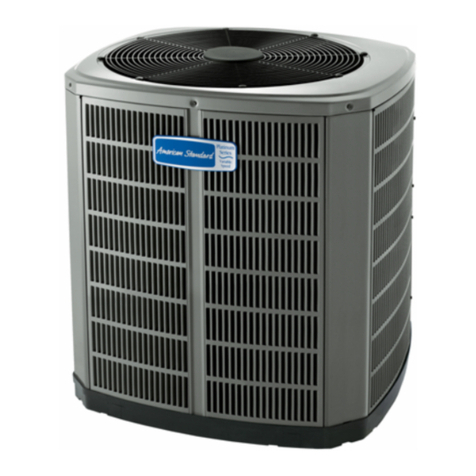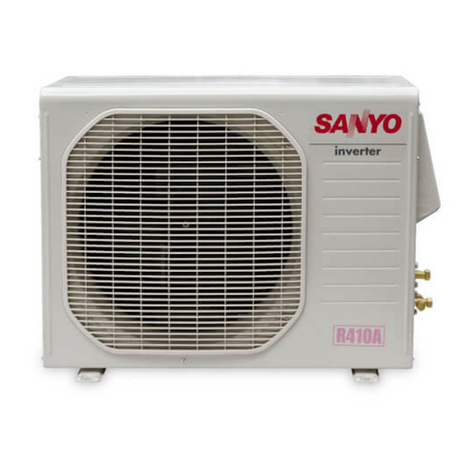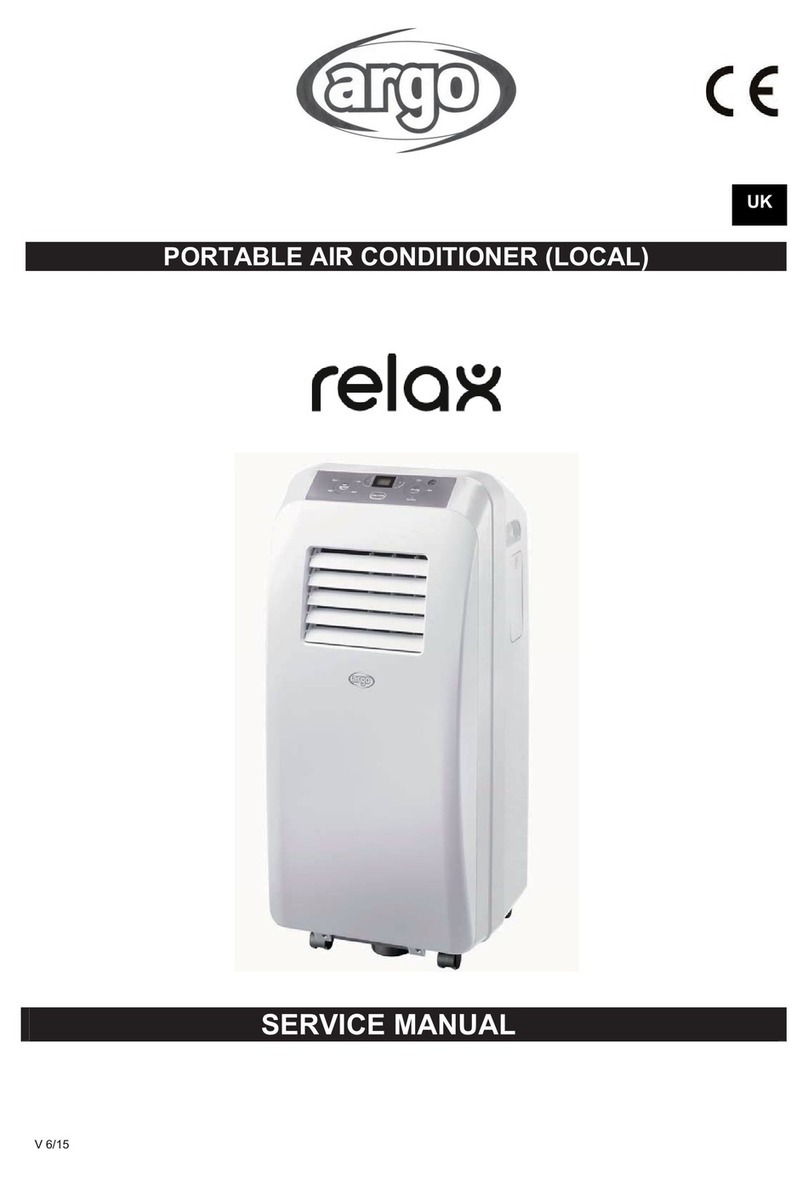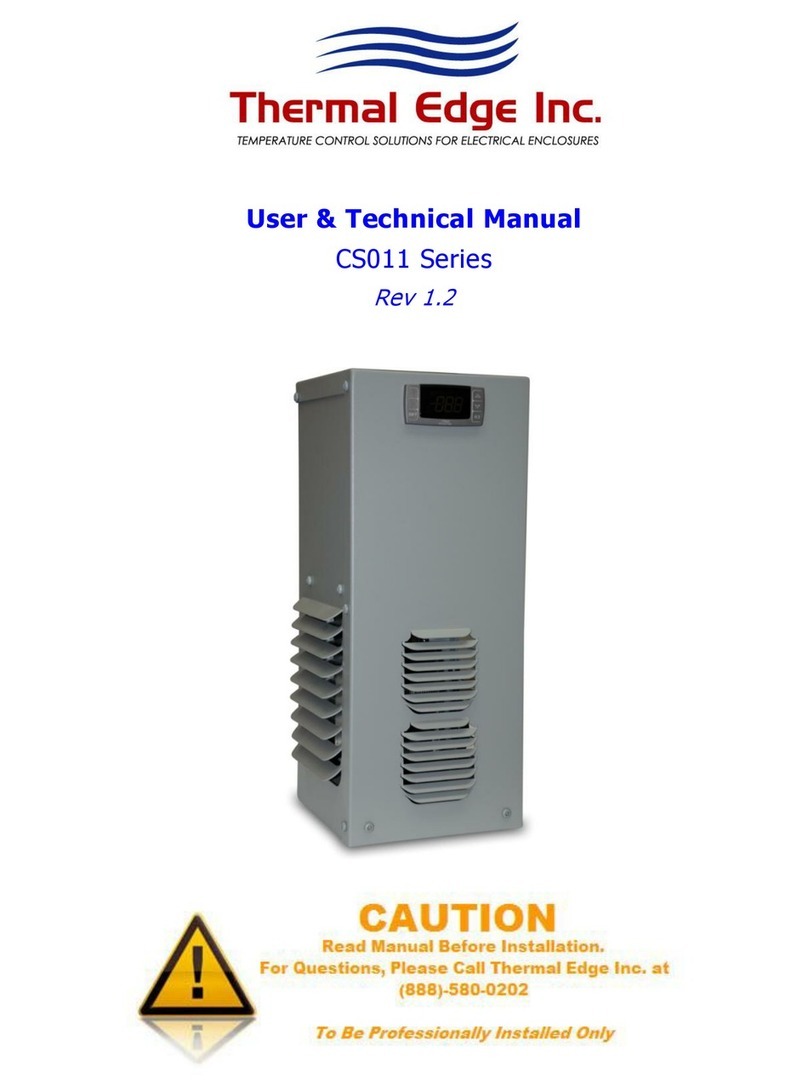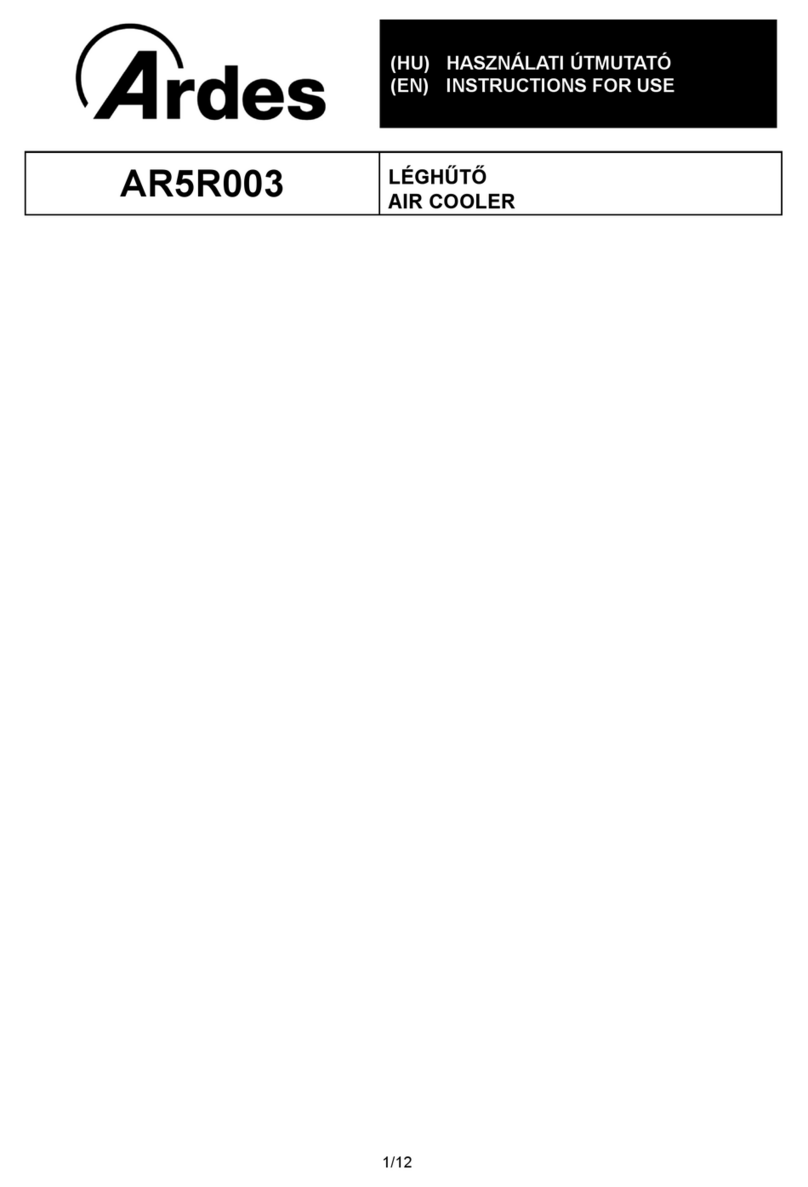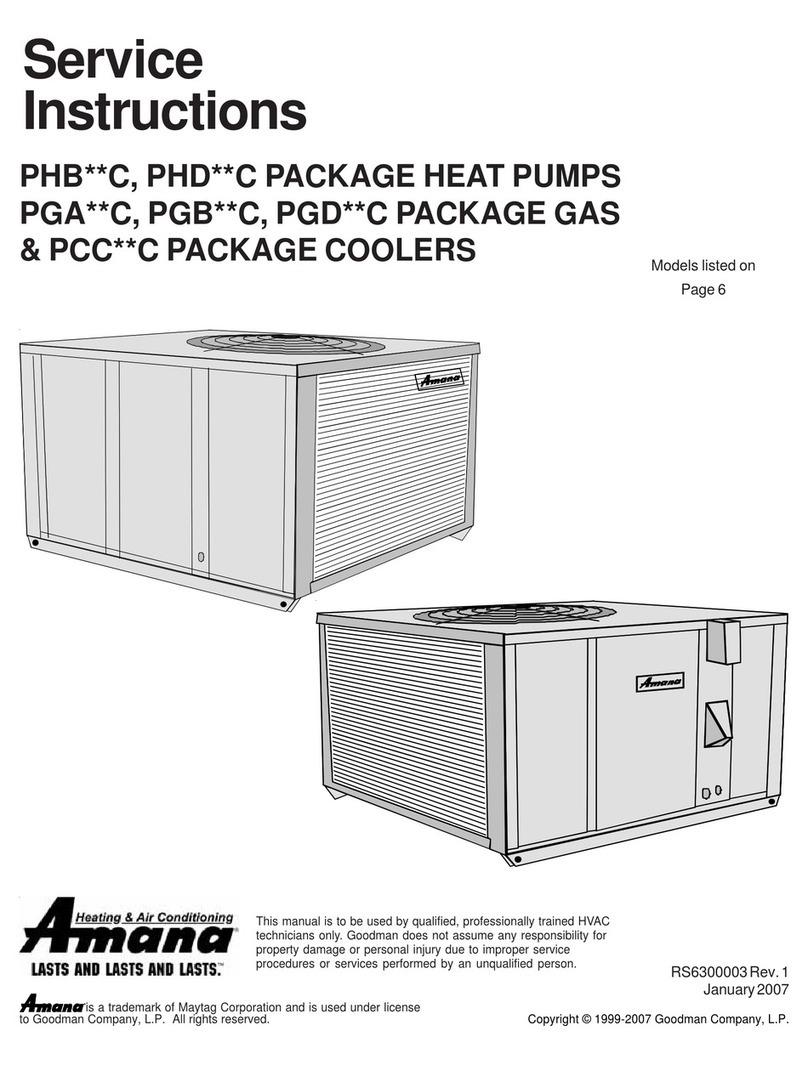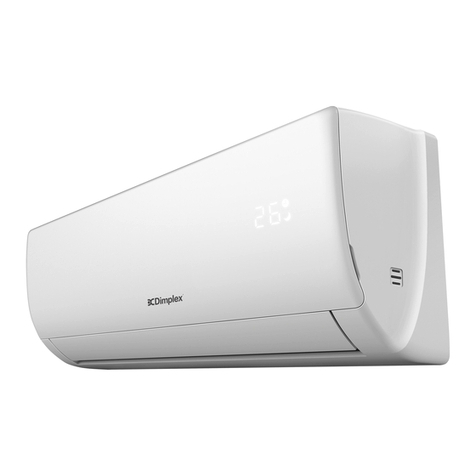Trox Technik X-CUBE compact User manual

Air handling unit
X-CUBE compact
Transport and installation manual
Read the instructions prior to performing any task!
including X-CUBE compact accessories
GB/en

A00000052582, 4, GB/en
© TROX GmbH 2015
TROX GmbH
Heinrich-Trox-Platz
47504 Neukirchen-Vluyn
Germany
Telephone: +49 2845 202-0
Fax: +49 2845 202-265
E-mail: [email protected]
Internet: www.troxtechnik.com
06/2018
Air handling unit X-CUBE compact
2

About this manual
This transport and installation manual enables operating
or service personnel to use the X-CUBE compact air
handling unit (AHU) safely and efficiently.
The transport and installation manual must be kept near
the unit to be available for use at all times.
This transport and installation manual is intended for
use by fitting and installation companies, operators, in-
house technicians, technical staff or instructed persons,
and skilled qualified electricians or air conditioning tech-
nicians.
It is essential that these individuals read and fully under-
stand this transport and installation manual before
starting any work. The basic prerequisite for safe
working is to comply with the safety notes and all
instructions in this manual.
The local regulations for health and safety at work and
the general safety regulations for the area of application
of the air handling unit also apply.
Illustrations in this transport and installation manual are
mainly for information and may differ from the actual
design of the air handling unit.
Copyright
This document, including all illustrations, is protected by
copyright and pertains only to the corresponding unit.
Any use without our consent may be an infringement of
copyright, and the violator will be held liable for any
damage.
This applies in particular to:
Publishing content
Copying content
Translating content
Microcopying content
Saving content to electronic systems and editing it
TROX Technical Service
To ensure that your request is processed as quickly as
possible, please keep the following information ready:
Product name
TROX order number
Delivery date
Brief description of the fault
Online www.troxtechnik.com
Phone +49 2845 202-400
Limitation of liability
The information in this manual has been compiled with
reference to the applicable standards and guidelines,
the state of the art, and our expertise and experience of
many years.
The manufacturer does not accept any liability for dam-
ages resulting from:
Non-compliance with this manual
Incorrect use
Operation or handling by untrained individuals
Unauthorised modifications
Technical changes
Use of non-approved replacement parts
The actual scope of delivery may differ from the infor-
mation in this manual for bespoke constructions, addi-
tional order options or as a result of recent technical
changes.
The obligations agreed in the order, the general terms
and conditions, the manufacturer's terms of delivery,
and the legal regulations in effect at the time the con-
tract is signed shall apply.
We reserve the right to make technical changes.
Defects liability
For details regarding defects liability please refer to
Section VI, Warranty Claims, of the Delivery and Pay-
ment Terms of TROX GmbH.
The Delivery and Payment Terms of TROX GmbH are
available at www.troxtechnik.com.
Other applicable documentation
In addition to these instructions, the following docu-
ments apply:
Order confirmation
Air handling unit data sheet from TROX GmbH
Product drawings
Data sheets for components from other suppliers, if
any
Circuit diagram for the air handling unit
Additional drawings, if any
X-CUBE compact operating manual
Installation and commissioning manual for X-CUBE
compact accessories
Supplemental instructions
Air handling unit X-CUBE compact 3

Safety notes
Symbols are used in this manual to alert readers to
areas of potential hazard. Signal words express the
degree of the hazard.
Comply with all safety instructions and proceed carefully
to avoid accidents, injuries and damage to property.
DANGER!
Imminently hazardous situation which, if not avoided,
will result in death or serious injury.
WARNING!
Potentially hazardous situation which, if not avoided,
may result in death or serious injury.
CAUTION!
Potentially hazardous situation which, if not avoided,
may result in minor or moderate injury.
NOTICE!
Potentially hazardous situation which, if not avoided,
may result in property damage.
ENVIRONMENT!
Environmental pollution hazard.
Tips and recommendations
Useful tips and recommendations as well as informa-
tion for efficient and fault-free operation.
Safety notes as part of instructions
Safety notes may refer to individual instructions. In this
case, safety notes will be included in the instructions
and hence facilitate following the instructions. The
above listed signal words will be used.
Example:
1. Untighten the screw.
2.
CAUTION!
Danger of finger entrapment when closing
the lid.
Be careful when closing the lid.
3. Tighten the screw.
Specific safety notes
The following symbols are used in safety notes to alert
you to specific hazards:
Warning signs Type of danger
Warning – hand injuries.
Warning - danger of
falling.
Warning – danger zone.
Supplemental instructions
Air handling unit X-CUBE compact4

1 Overview............................................................. 6
2Safety.................................................................. 8
2.1 System owner's responsibility..................... 8
2.2 Personnel requirements.............................. 8
2.3 Personal protective equipment.................... 9
3 Transport and storage..................................... 10
3.1 Delivery of the air handling unit................. 10
3.1.1 Complete and partial units...................... 10
3.1.2 Symbols on the packaging..................... 10
3.2 Delivery check........................................... 10
3.3 Moving packages....................................... 11
3.3.1 Safety notes regarding transport............ 11
3.3.2 Moving packages with a forklift or pallet
truck........................................................ 12
3.3.3 Moving packages with a crane............... 13
3.4 Storing packages....................................... 15
3.5 Unpacking................................................. 15
4 Setup and assembly........................................ 17
4.1 Safety notes regarding setup and
assembly................................................... 17
4.2 Requirements for the installation loca-
tion............................................................. 17
4.2.1 Requirements for indoor installation....... 17
4.2.2 Requirements for outdoor installation..... 18
4.3 Preventing vibration and structure-borne
noise.......................................................... 19
4.4 Setting up and assembling the air han-
dling unit.................................................... 19
4.4.1 Setting up the AHU or AHU casing
units........................................................ 19
4.4.2 Before assembly..................................... 20
4.4.3 Assembling AHU casing units................ 21
4.4.4 Installing accessories............................. 24
5 Installation........................................................ 26
5.1 Safety notes regarding installation............ 26
5.2 Before installation...................................... 26
5.3 Changing the operating side..................... 27
5.4 Connecting the condensate drain.............. 28
5.5 Connecting the heating coil/cooling
coil............................................................. 30
5.6 Connecting the air handling unit to the
power supply............................................. 32
5.7 Integrating the air handling unit with the
central BMS............................................... 32
5.8 Connecting the air handling unit to your
PC or local network................................... 32
6 Initial commissioning...................................... 34
6.1 Safety notes regarding initial commis-
sioning....................................................... 34
6.2 Before initial commissioning...................... 34
6.3 Setting up and adjusting AHU casing
units........................................................... 35
6.3.1 Filter................................................ 35
6.3.2 Heating coil/cooling coil.................... 35
6.3.3 Multileaf dampers................................ 36
6.3.4 Rotary heat exchanger........................ 37
6.3.5 Droplet eliminator................................... 38
6.3.6 Plate heat exchanger.......................... 39
6.3.7 Setting up accessories........................... 39
6.4 Starting the air handling unit...................... 39
6.4.1 Before you start the AHU....................... 39
6.4.2 Starting................................................... 39
6.5 Configuring the air handling unit................ 40
6.5.1 Setting up X-CUBE controller communi-
cation...................................................... 40
6.5.2 Setting up network communication........ 41
6.6 Logging in to the web server..................... 42
7 Disassembly and disposal.............................. 43
7.1 Safety notes regarding disassembly and
disposal..................................................... 43
7.2 Disassembly.............................................. 44
7.3 Disposal..................................................... 44
8 FAQ................................................................... 45
9 Index................................................................. 47
Appendix.......................................................... 49
A Adjusting the storage mass.......................... 50
B Drive equipment for rotary heat exchanger.. 56
C Circuit diagram, controls tray, 230 V AC-
PWT............................................................. 62
D Circuit diagram, controls tray, 230 V AC-
RWT............................................................. 76
E Circuit diagram, controls tray, 400 V AC-
PWT............................................................. 90
F Circuit diagram, controls tray, 400 V AC-
RWT........................................................... 104
G Accessories for X-CUBE compact............. 118
Table of contents
Air handling unit X-CUBE compact 5

1 Overview
Unit with rotary heat exchanger
Fig. 1: Unit with rotary heat exchanger
1 Multileaf dampers
2 Centrifugal fan
3 Rotary heat exchanger
4 X-CUBE control
5 Filter
6 Centrifugal fan
7 Multileaf dampers
8 Filter
FOL Exhaust air
ABL Extract air
ZUL Supply air
AUL Outdoor air
Overview
Air handling unit X-CUBE compact6

Unit with plate heat exchanger
Fig. 2: Unit with plate heat exchanger
1 Multileaf dampers
2 Filter
3 Plate heat exchanger
4 X-CUBE control
5 Filter
6 Centrifugal fan
7 Multileaf dampers
8 Centrifugal fan
AUL Outdoor air
ABL Extract air
ZUL Supply air
FOL Exhaust air
The components actually used for a particular X-CUBE compact unit depend on the order specification. The fol-
lowing table (
Ä
Table on page 7) lists the components that can make up an X-CUBE compact unit.
Symbol Meaning Symbol Meaning
Heating coil Multileaf dampers
(Fig. 1/1+7)
(Fig. 2/1+7)
Cooling coil Centrifugal fan
(Fig. 1/2+6)
(Fig. 2/6+8)
Filter
(Fig. 1/5+8)
(Fig. 2/2+5)
Plate heat exchanger
(Fig. 2/3)
Rotary heat exchanger
(Fig. 1/3)
Roof for outdoor installation
X-CUBE control (controls)
(Fig. 1/4)
(Fig. 2/4)
Overview
Air handling unit X-CUBE compact 7

2 Safety
2.1 System owner's responsibility
System owner
The system owner is a natural or legal person who for
commercial or business purposes owns or manages the
air handling unit or allows third parties to use or operate
it, but continues to bear legal responsibility for the safety
of users, staff or third parties while the product is in use.
System owner's obligations
The unit is intended for commercial use. The system
owner is therefore subject to the legal obligations of
occupational health and safety regulations.
In addition to the safety notes in this manual, the appli-
cable regulations for safety, accident prevention and
environmental protection must also be complied with.
In particular:
The system owner must establish on site a coherent
fire protection strategy and include the air handling
unit in this strategy.
The system owner must establish on site a coherent
lightning protection strategy and include the air han-
dling unit in this strategy.
The system owner must name responsible persons
for transport, storage, assembly, installation, com-
missioning, transfer, disassembly and removal of the
unit.
The system owner must commission a skilled quali-
fied electrician to create equipotential bonding.
The system owner has to ensure that all individuals
who handle or use the air handling unit have read
and understood this manual.
The system owner must provide the employees with
the required personal protective equipment.
The system owner must have all safeguards tested
regularly to ensure that they are functional and com-
plete.
The system owner must ensure compliance with the
national legal provisions.
The system owner must have technical and hygiene
tests carried out and documented before commis-
sioning the air handling unit for the first time. The
tests have to be repeated at regular intervals.
2.2 Personnel requirements
WARNING!
Danger of injury or risk of damage to property
due to insufficiently qualified individuals!
Insufficiently qualified individuals are not aware of
the risks involved in working with the air handling unit
and are hence likely to put themselves or others into
danger, causing severe or fatal injuries.
– Have any work carried out only by qualified per-
sonnel.
–Keep insufficiently qualified individuals away
from the work area.
Crane driver
Crane drivers are physically and mentally able to
operate a crane on their own.
Crane drivers are qualified to operate a crane and have
proven the required skillset to the system owner.
Crane drivers are commissioned by the system owner.
Crane drivers are commissioned in writing if the crane is
a mobile crane.
Crane drivers have to be at least 18 years old.
Forklift driver
Forklift drivers are qualified to operate driver-operated
forklift trucks; they are commissioned in writing by the
system owner to operate such a truck.
Forklift drivers are responsible for moving pallets.
HVAC technician
HVAC technicians are individuals who have sufficient
professional or technical training in the field they are
working in to enable them to carry out their assigned
duties at the level of responsibility allocated to them and
in compliance with the relevant guidelines, safety regu-
lations and instructions. HVAC technicians are individ-
uals who have in-depth knowledge and skills related to
HVAC systems; they are also responsible for the profes-
sional completion of the work under consideration.
HVAC technicians are individuals who have sufficient
professional or technical training, knowledge and actual
experience to enable them to work on HVAC systems,
understand any potential hazards related to the work
under consideration, and recognise and avoid any risks
involved.
Skilled qualified electrician
Skilled qualified electricians are individuals who have
sufficient professional or technical training, knowledge
and actual experience to enable them to work on elec-
trical systems, understand any potential hazards related
to the work under consideration, and recognise and
avoid any risks involved.
Safety
Personnel requirements
Air handling unit X-CUBE compact8

2.3 Personal protective equipment
Hearing protection
Hearing protection protects against hearing damage
resulting from noise exposure.
Industrial safety helmet
Industrial safety helmets protect the head from falling
objects, suspended loads, and the effects of striking the
head against stationary objects.
Protective clothing
Protective clothing is close-fitting, with low tear resist-
ance, close-fitting sleeves, and no projecting parts.
Protective gloves
Protective gloves protect hands from friction, abrasions,
punctures, deep cuts, and direct contact with hot sur-
faces.
Safety harness
The safety harness protects personnel from falling when
there is an increased risk of falling. The risk of falling is
increased when certain height differences are exceeded
and the workspace is not secured by a railing.
The safety harness must be worn in such a way that the
safety rope is connected to the safety harness and to a
secure attachment point; provide shock absorbers if
necessary.
Safety harnesses must only be used by personnel who
have been specifically trained to use them.
Safety shoes
Safety shoes protect the feet from crushing, falling parts
and prevent slipping on a slippery floor.
Safety
Personal protective equipment
Air handling unit X-CUBE compact 9

3 Transport and storage
3.1 Delivery of the air handling unit
3.1.1 Complete and partial units
Upon delivery, check the air handling unit for transport
damage and completeness,
Ä
Chapter 3.2 ‘Delivery
check’ on page 10.
Depending on its size, the air handling unit is shipped
either fully assembled or in parts, with the individual
components or casing units screw-fixed to square edge
timber frames or disposable pallets. The number of
parts is shown on a drawing on the package.
External components may be shipped unassembled
to protect them from getting entangled with lifting
eyes while being moved. Components for outdoor
installation have to be assembled, mounted and
sealed by others.
3.1.2 Symbols on the packaging
Lashing points are marked on the packaging. Be sure to
follow them when you are moving the unit.
The packaging may also carry other symbols, notes,
and information. Be sure to take notice of them.
Lashing point
Fig. 3: Lashing point
Always use a central lashing point for lifting and moving
the air handling unit to ensure that it remains stable and
cannot tip, slip, swing or fall unintentionally.
3.2 Delivery check
Sharp edges, sharp corners and thin sheet metal
parts
CAUTION!
Danger of injury from sharp edges, sharp cor-
ners and thin sheet metal parts!
Sharp edges, sharp corners and thin sheet metal
parts of the heat exchanger or of the cooling or
heating coil may cause cuts or grazes.
– Be careful when working on these components.
–Wear protective gloves, safety shoes and a hard
hat.
Check delivered items immediately after arrival for
transport damage and completeness. In case of any
damage or an incomplete shipment, contact the ship-
ping company and your supplier immediately. If any
parts are missing, have the driver confirm them on the
consignment note.
Otherwise the manufacturer will not accept any liability.
See the notes on shipping damage on the packaging
or in the shipping papers.
For any claims it is necessary that you follow the proce-
dure below. In each of the following cases do contact
TROX before you start installing a unit.
The packaging has been damaged
Unpack the goods in the presence of the person
who has delivered the goods and have them confirm
the damage on the shipping order.
Photograph the damage.
Report the damage to TROX immediately.
No external damage to packaging, contents dam-
aged.
Photograph the damage.
Report the damage to TROX immediately in writing.
Note that shipping damage must be reported within
four days of delivery.
Transport and storage
Delivery check
Air handling unit X-CUBE compact10

3.3 Moving packages
3.3.1 Safety notes regarding transport
Improper transport equipment
WARNING!
Risk to life from using improper transport equip-
ment!
If packages are lifted without adequate transport
equipment and if they are not properly secured, they
may fall off and lead to fatal injuries.
– Move components only in the position in which
they are to be installed.
–Stand clear of suspended loads.
– Do not move additional loads on top of a
package.
– Use only the intended lashing points.
– Make sure that no load is imposed on pipes,
ducts or cables.
– Use only approved lifting gear and slings that are
suitable and sufficient for the load to be carried.
– Do not tie ropes and chains or make knots or
place them on sharp edges.
– Use lifting equipment only to lift packages or
units, not to push or pull them.
– Ensure that ropes, belts and chains do not twist.
– Ensure that transport equipment has been cor-
rectly assembled, fastened and secured before
you use it to lift anything.
– Secure all doors, dampers and panels.
– Move packages without any jerky movements
and put them down when you leave your work-
place.
– Lifting eyes are designed for one-time use only
and not for permanently suspending loads.
– Transport tubes are designed for one-time use
only and not for permanently suspending loads.
Unbalanced loads and centre of gravity
WARNING!
Risk of injury from falling or toppling loads!
Loads may be unbalanced, i.e. the centre of gravity
may not be obvious. If the load is not properly
attached to the lifting equipment, it may topple and
fall. Falling or toppling loads can cause serious inju-
ries.
– Note that the centre of gravity is marked on each
package.
–When you use a crane to move loads, ensure
that the centre of gravity of the load is directly
beneath the crane hook.
– Lift any load carefully and keep an eye on it to
see whether it will stay in place. If required,
change the lashing point(s).
Sticker indicating the centre of gravity
Fig. 4: Shipping stickers
Stickers on the packaging indicate the centre of gravity
(Fig. 4).
Sharp edges, sharp corners and thin sheet metal
parts
CAUTION!
Danger of injury from sharp edges, sharp cor-
ners and thin sheet metal parts!
Sharp edges, sharp corners and thin sheet metal
parts of the heat exchanger or of the cooling or
heating coil may cause cuts or grazes.
– Be careful when working on these components.
–Wear protective gloves, safety shoes and a hard
hat.
Transport and storage
Moving packages > Safety notes regarding transport
Air handling unit X-CUBE compact 11

Damage to goods being moved
NOTICE!
Risk of damage to property due to the incorrect
handling or lifting of units!
If you handle or move packages incorrectly, they
may topple or fall. This can cause considerable
damage to property.
– Do not put down packages hard and do not
knock against them with force. Watch out for pro-
truding parts.
– When you are moving units for outdoor installa-
tion, be careful that the thin metal roof is not
damaged by the lifting gear.
3.3.2 Moving packages with a forklift or
pallet truck
Air handling units differ in weight and may have different
lashing points. See the order-specific technical docu-
ments for details.
Personnel:
Forklift driver
Protective equipment:
Industrial safety helmet
Protective clothing
Safety shoes
Protective gloves
NOTICE!
Risk of damage to property from forklifts or
pallet trucks!
Take proper precautions when you use a forklift or
pallet truck to move or lift parts or components of an
air handling unit as otherwise they may be damaged.
– If you want to use a forklift to lift a package
without a base frame, you need to protect the
casing units properly.
Fig. 5: Carrying load with a forklift
1. Drive the forklift forward until the forks (Fig. 5/3)
are fully between the square edge timber sections
(Fig. 5/2) and protrude from underneath the base
frame (Fig. 5/1) on the opposite side.
2. Ensure that the load cannot tip.
3. Slowly lift the load and start moving.
Transport and storage
Moving packages > Moving packages with a forklift or pallet truck
Air handling unit X-CUBE compact12

3.3.3 Moving packages with a crane
Moving units with transport tubes and ropes/chains
There are two ways to move AHU casing units: either
with ropes/chains or with transport tubes.
Use only transport tubes with a length that is adequate
for the AHU casing unit to be moved. The table below
(
Ä
‘Transport tubes’ on page 13) shows the recom-
mended minimum lengths for transport tubes.
Transport tubes
Overall width of AHU
casing unit [mm]
Length of transport tube
[mm]
612 1058
918 1364
1224 1670
The transport tubes are not included in the air handling
unit supply package. Use only transport tubes that are
suitable for the required load (see table
Ä
‘Moving units
with transport tubes and ropes/chains’ on page 13).
Designa-
tion
Outer
diameter
[mm]
Wall thick-
ness [mm]
Max.
weight of
AHU
casing unit
[kg]
Seamless
steel tube,
S235J2H
48.3 5 £ 1500
You may also use other tubes which are suitable for the
same or a higher load.
Personnel:
Crane driver
Protective equipment:
Industrial safety helmet
Protective clothing
Hearing protection
Safety shoes
Protective gloves
NOTICE!
Risk of damage to property from a crane!
Take proper precautions when you use a crane to
move or lift parts or components of an air handling
unit as otherwise they may be damaged.
– Protect the edges of the AHU casing units with
wood blocks.
–Spread the wire ropes or chains near the roof
with a suitable device.
Fig. 6: Moving units with a crane and transport tubes
1. Remove the plugs from the drilled holes in the
base frame (Fig. 6/5) of the AHU casing unit.
2. Push transport tubes (Fig. 6/4) through the drilled
holes in the base frame.
3. Place the loops of the ropes or chains (Fig. 6/2)
around the ends of the transport tubes.
DANGER!
Danger of death from the fall of suspended
loads!
Potentially fatal situations may occur if the
chains or wire ropes slip off the transport
tubes.
Ensure that the chains or ropes cannot slip.
4. Protect the edges with wood blocks (Fig. 6/3).
5. Spread the slings near the roof with a suitable
device (Fig. 6/1).
6. Ensure that the slings cannot damage the AHU
casing unit.
7. Suspend (distribute) the load symmetrically, i.e. in
such a way that its centre of gravity is beneath the
crane hook.
8. Slowly lift the load and start moving.
Transport and storage
Moving packages > Moving packages with a crane
Air handling unit X-CUBE compact 13

Moving units for indoor installation with a crane and
lifting eyes/eye nuts and ropes/chains
Without a spreader beam
Personnel:
Crane driver
Protective equipment:
Industrial safety helmet
Protective clothing
Hearing protection
Safety shoes
Protective gloves
WARNING!
Danger of death from the fall of AHU casing
units.
If you overload lashing points or lifting gear, the load
may fall down. You or others could be killed.
– Use lifting eyes only to move AHU casings for
indoor installation, and only for casing units up to
a maximum weight of 1500 kg.
Fig. 7: Moving units with a crane and lifting eyes or eye
nuts (without a spreader beam)
1. Remove the covers from the threaded holes in the
top corners of the AHU casing unit.
2. Insert all lifting eyes or eye nuts (Fig. 7/2) com-
pletely into the threaded holes.
3. Hook the slings (Fig. 7/1) into the lifting eyes or
eye nuts.
We recommend using a chain hoist and
spreader beam if there are six or more lashing
points.
4. Maintain an angle greater than 45° between the
rope or chain and the top of the unit.
5. Do not spread slings by more than 60°.
6. Ensure that the slings cannot damage the AHU
casing unit.
7. Suspend (distribute) the load symmetrically, i.e. in
such a way that its centre of gravity is beneath the
crane hook.
8. Slowly lift the load and start moving.
Transport and storage
Moving packages > Moving packages with a crane
Air handling unit X-CUBE compact14

With a spreader beam
Personnel:
Crane driver
Protective equipment:
Industrial safety helmet
Protective clothing
Hearing protection
Safety shoes
Protective gloves
WARNING!
Danger of death from the fall of AHU casing
units.
If you overload lifting eyes, the load may fall down.
You or others could be killed.
– Use lifting eyes only to move AHU casings for
indoor installation, and only for casing units up to
a maximum weight of 1500 kg.
Fig. 8: Moving units with a crane and lifting eyes or eye
nuts (with a spreader beam)
1. Remove the covers from the threaded holes in the
top corners.
2. Insert all lifting eyes or eye nuts (Fig. 8/1) com-
pletely into the threaded holes.
3. Hook the spreader beams (Fig. 8/3) into the lifting
eyes or eye nuts.
4. Connect the spreader beams with chains
(Fig. 8/2).
5. Do not spread slings by more than 60°.
6. Suspend (distribute) the load symmetrically, i.e. in
such a way that its centre of gravity is beneath the
crane hook.
7. Slowly lift the load and start moving.
3.4 Storing packages
If you have to store packages temporarily:
Do not store outdoors.
Set down on even ground.
Store in a dry and dust free place.
Do not expose to any aggressive gases or liquids.
Store away from direct sunlight.
Do not expose to sudden temperature changes or
excessive temperatures.
Storage temperature -10 °C to +50 °C, with no risk
of condensation.
Store units only with packaging (original or any other
suitable protective packaging).
Protective packaging has to allow for sufficient venti-
lation on all sides as otherwise condensation will
form.
Close any connection openings.
If a unit has to be stored for more than 3 months,
regularly check the general condition of all parts and
of the packaging. Refresh corrosion protection, if
necessary.
NOTICE!
Risk of damage to property due to white rust!
Galvanised parts wrapped in plastic without ade-
quate ventilation are susceptible to corrosion, espe-
cially if moisture is present.
–Remove protective film, if any.
– Store all units in a dry place.
Note!
Packages may contain additional important informa-
tion on storage requirements. Be sure to read it.
3.5 Unpacking
Unless packaging or the contents have been damaged
while in transit, remove the packaging only when you
are ready to start installation
Ä
Chapter 3.2 ‘Delivery
check’ on page 10.
Transport and storage
Unpacking
Air handling unit X-CUBE compact 15

ENVIRONMENT!
Risk of harm to the environment due to incorrect
disposal of goods and packaging!
Packaging materials can, in many cases, be recondi-
tioned and recycled. Incorrect disposal of packaging
can harm the environment.
– Dispose of packaging materials in an environ-
mentally friendly manner in accordance with the
local waste disposal regulations.
–If necessary, employ a specialist disposal com-
pany to dispose of the packaging.
Transport and storage
Unpacking
Air handling unit X-CUBE compact16

4 Setup and assembly
If an air handling unit is shipped in several parts, you
have to erect and assemble it on site.
4.1 Safety notes regarding setup and
assembly
Setup and assembly
WARNING!
Risk to life from incorrect setup and assembly!
The incorrect setup and assembly of AHU casing
units can lead to potentially fatal situations and
cause considerable damage to property. Incorrect
setup and assembly will also impair the function of
the unit.
– Air handling units must only be set up and
assembled by HVAC technicians.
Working at height
WARNING!
Risk of a fall when you work at height!
Working at height without using any fall protection
equipment, or using unsuitable or damaged equip-
ment to get up to where you work at height, may lead
to yourself or others falling from height; people on
the ground may be at risk from falling parts or tools.
This can cause serious or even fatal injuries.
– Only use equipment that is suitable, stable and
strong enough for the job, maintained and
checked regularly.
– Stop materials or objects from falling.
– Wear safety shoes, protective clothing and a
hard hat.
– Wear a safety harness.
Interconnecting units and systems
WARNING!
Risk of injury from interconnecting different
units or systems!
Connecting an air handling unit to other units or sys-
tems (e.g. ductwork, pumps, refrigeration systems)
can lead to dangerous situations and eventually
cause serious or even fatal injuries.
– If you have to connect other units or systems to
the air handling unit, connect them professio-
nally.
– The system owner/HVAC contractor is respon-
sible for the planning and installation of any addi-
tional safeguards.
Sharp edges, sharp corners and thin sheet metal
parts
CAUTION!
Danger of injury from sharp edges, sharp cor-
ners and thin sheet metal parts!
Sharp edges, sharp corners and thin sheet metal
parts of the heat exchanger or of the cooling or
heating coil may cause cuts or grazes.
– Be careful when working on these components.
–Wear protective gloves, safety shoes and a hard
hat.
4.2 Requirements for the installation
location
4.2.1 Requirements for indoor installation
Installation room
Air handling units designed for indoor installation have
to be installed in a room that meets the following
requirements:
The room has been designed in compliance with the
applicable building regulations and is suitable for the
technical systems to be installed. National standards
for plant rooms may also apply.
The room is:
– clean
– dry
– free from conductive dust particles
– free from strong electromagnetic fields
– free from aggressive atmospheres
– free from frost
– fitted with a functioning drainage system
Setup and assembly
Requirements for the installation location > Requirements for indoor installation
Air handling unit X-CUBE compact 17

There is sufficient clearance for installing, operating,
servicing, and repairing the AHU and all its parts.
The maintenance access is at least as deep as the
unit.
The structure on which the air handling unit is to be
installed must be suitable for the weight and have a
level surface (see the order-specific data sheet for
the air handling unit).
Do not use the air handling unit as a structural ele-
ment or as a roof for a building.
Do not use the air handling unit in potentially explo-
sive atmospheres.
Escaping water
NOTICE!
Risk of damage to property from escaping water!
If the water system is not tight, water may escape
and cause considerable damage to property.
– Ensure that liquids are channelled away and to a
collection device.
Condensation
NOTICE!
Condensation can cause physical damage!
If outdoor temperatures are low and the system is
not running, condensation may occur in the air han-
dling unit due to moist air in the building.
– Shut off the ducts with dampers or install an air
heater to prevent condensation in the air han-
dling unit.
Installation room foundation
The installation room foundation must fulfil the following
requirements:
It is horizontal, flat and robust, made of concrete;
alternatively, a supporting structure made of steel
may be used.
The frequency of the supporting structure, particu-
larly of a steel structure, is sufficiently different from
the excitation frequency of movable components,
such as fans, motors, pumps or refrigerant con-
densers.
For air handling units with a condensate drain, the
supporting structure is at least as high as the drain
trap, see
Ä
Chapter 5.4 ‘Connecting the conden-
sate drain’ on page 28
If additionally structure-borne noise is to be attenu-
ated (e.g. by rubber or elastomer sheets underneath
the air handling unit), be sure to exactly align all
AHU casing units (check for door closure, properly
sealed joints).
4.2.2 Requirements for outdoor installa-
tion
Installation location
For outdoor installation please note:
Do not use the air handling unit in potentially explo-
sive atmospheres.
The installation location has to be
–free from conductive dust particles
– free from strong electromagnetic fields
– free from aggressive atmospheres
– fitted with a functioning drainage system
The structure on which the air handling unit is to be
installed must be suitable for the weight and have a
level surface (see the order-specific data sheet for
the air handling unit).
There is sufficient clearance for installing, operating,
servicing, and repairing the AHU and all its parts.
The maintenance access has to be at least as deep
as the unit.
Make sure that the installation location meets local
regulations to prevent the fall of people, and of tools
and other objects.
Use suitable fall arrest equipment.
Prevent unauthorised individuals from accessing
AHU casing units.
Make sure that authorised individuals can access
AHU casing units safely.
Keep the structural properties in mind and make
sure the maximum roof load is not exceeded; do not
neglect the effects of weather on the unit (rain,
snow, wind, sun etc.).
Only a skilled qualified professional must connect
the air handling unit to an external switch cabinet
and prevent the cables from the effects of weather
(rain, snow, wind, sun etc.).
All operating fluid pipes and hoses and the AHU
components to which they are connected must be
frost-proof.
Do not use the air handling unit as a structural ele-
ment or as a roof for a building.
Setup and assembly
Requirements for the installation location > Requirements for outdoor installation
Air handling unit X-CUBE compact18

Foundation of the outdoor installation area
The information regarding the foundation of the
installation room applies,
Ä
‘Installation room foun-
dation’ on page 18
For roof installation, check the load capacity and
support structure of the roof; consult an engineer if
necessary.
The entire air handling unit must be supported by a
continuous steel structure.
The steel girders must be designed for a maximum
deflection of L/500 under load (L = girder length). A
maximum deflection of 10 mm under load must not
be exceeded.
Waterproof the edge of the roof under the air han-
dling unit and also any connections penetrating the
roof.
Insulate the plinth structure (by others) to prevent
condensation.
In areas with heavy snowfall, choose an installation
location where snow will not affect the operation of
the air handling unit. Make sure that the supporting
structure is high enough.
Escaping water
NOTICE!
Risk of damage to property from escaping water!
If the water system is not tight, water may escape
and cause considerable damage to property.
– Ensure that liquids are channelled away and to a
collection device.
4.3 Preventing vibration and structure-
borne noise
Anti-vibration elements or a noise insulating layer
underneath the air handling unit may help to reduce the
transmission of vibration from the air handling unit to the
supporting structure:
If the air handling unit is to be installed on level
ground with no special requirements regarding
structure-borne noise insulation, we recommend
placing rubber or elastomer sheets between the air
handling unit and the foundation.
For noise insulation, compare the requirement to the
sound power level of the air handling unit (see
order-specific data sheet for the air handling unit)
and have the necessary measures determined by
an acoustics engineer.
Use splitter sound attenuators if necessary.
NOTICE!
Risk of damage to the AHU
Anti-vibration elements or a noise insulating layer
must not affect the structural safety of the AHU.
Ensure the following:
– Use a sufficient number of anti-vibration ele-
ments and noise insulating layers and place
them correctly as otherwise the frame may sag.
– Keep in mind that the various AHU casing units
differ in weight; this must not lead to any height
differences in the overall unit.
We recommend you to have noise insulating layers
(including material and layout plan) selected and
sized by an expert company.
4.4 Setting up and assembling the air
handling unit
4.4.1 Setting up the AHU or AHU casing
units
Checking the seals on AHU casing units
Fig. 9: Seals on AHU casing units
Where two AHU casing units are to be joined, a perim-
eter seal (Fig. 9/1) is provided. Note that only one of the
units to be joined is fitted with a seal. The other unit
does not have a seal (Fig. 9/2).
Compressed seals will recover fully to their
original state about 60 minutes after the trans-
port protection devices have been removed.
Check that the seals are complete and intact and
that they seal properly.
Setup and assembly
Setting up and assembling the air handling unit > Setting up the AHU or AHU casing units
Air handling unit X-CUBE compact 19

Setting up AHU casing units
Personnel:
HVAC technician
Protective equipment:
Industrial safety helmet
Safety shoes
Protective gloves
Slide plates (Fig. 10/3) considerably simplify the
process of positioning the AHU casing units (Fig. 10/1)
on a surface with a high friction coefficient, such as
rubber or elastomer sheets (Fig. 10/4).
The arrangement of the AHU casing units is given in
the order-specific approval drawing.
Fig. 10: Unit arrangement with anti vibration elements
1.
The rubber or elastomer sheets are com-
pressed to a greater or lesser degree
depending on the weight of each AHU casing
unit. Be sure to adjust any resulting height dif-
ferences.
Position the slide plates (Fig. 10/3, by others)
under the base frames (Fig. 10/2) of the AHU
casing units (Fig. 10/1).
2.
For outdoor installation: Ensure that there is
still enough space to attach the self-adhesive
seal, see
Ä
‘Additional assembly steps for out-
door units’ on page 21.
Move the AHU casing units as close together as
possible.
Fig. 11: Aligning AHU casing units
3. Align the AHU casing units such that they are
flush with one another (Fig. 11/1).
Setting up units with a base frame
Fig. 12: Attaching a ratchet strap
1. Attach a ratchet strap to the base frames of two
AHU casing units (Fig. 12).
2. Tighten the ratchet strap.
ðThe AHU casing units come closer together as
you tighten the strap around the base frames.
4.4.2 Before assembly
Before assembly
Remove all transport tubes and transport protection
devices from the AHU casing units.
Have all the required tools ready.
Have all the applicable documents at hand.
Remove all separately supplied materials and
accessories from the AHU casing units.
Compressed seals will recover fully to their original
state about 60 minutes after the transport protection
devices have been removed.
Setup and assembly
Setting up and assembling the air handling unit > Before assembly
Air handling unit X-CUBE compact20
Other manuals for X-CUBE compact
1
Table of contents
Other Trox Technik Air Conditioner manuals
Popular Air Conditioner manuals by other brands

Daikin
Daikin Comfort Flex CLIV Series Installation, operation and maintenance manual
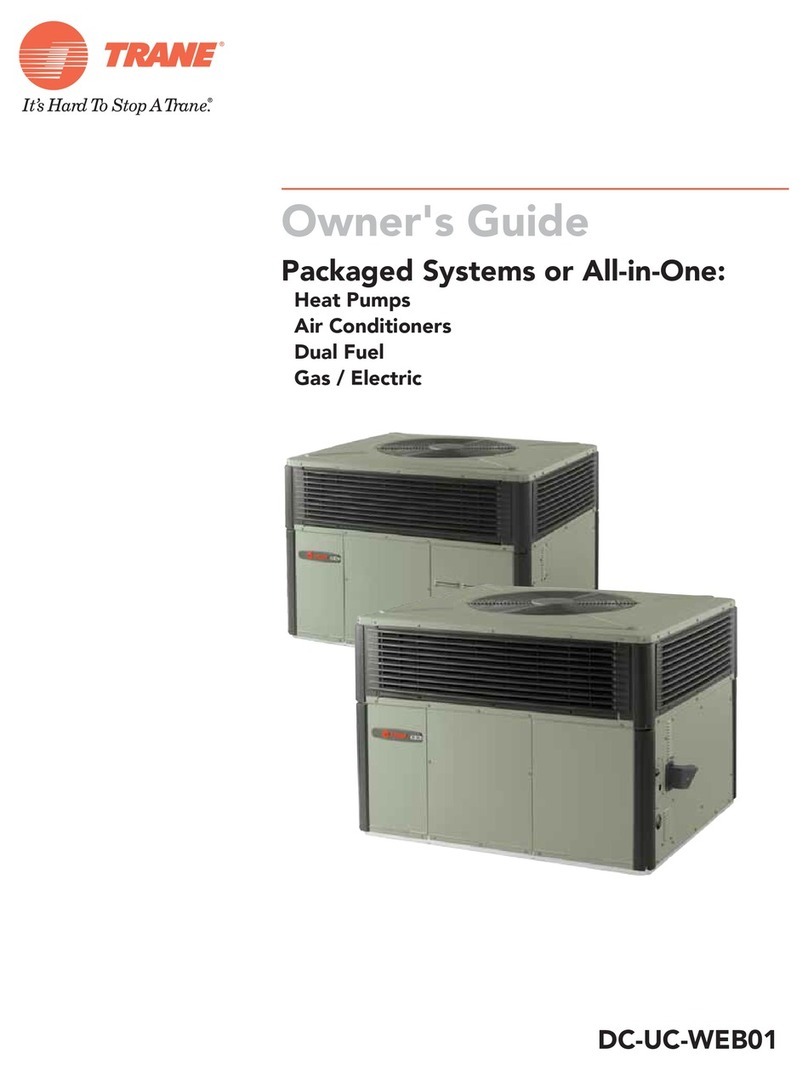
Trane
Trane DC-UC-WEB01 owner's guide
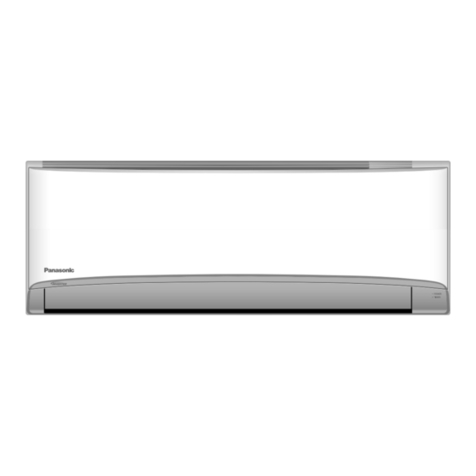
Panasonic
Panasonic CS-YS9TKV operating instructions

Ocean Breeze
Ocean Breeze OBZ-10ESN owner's manual

LG
LG MT11AH installation manual
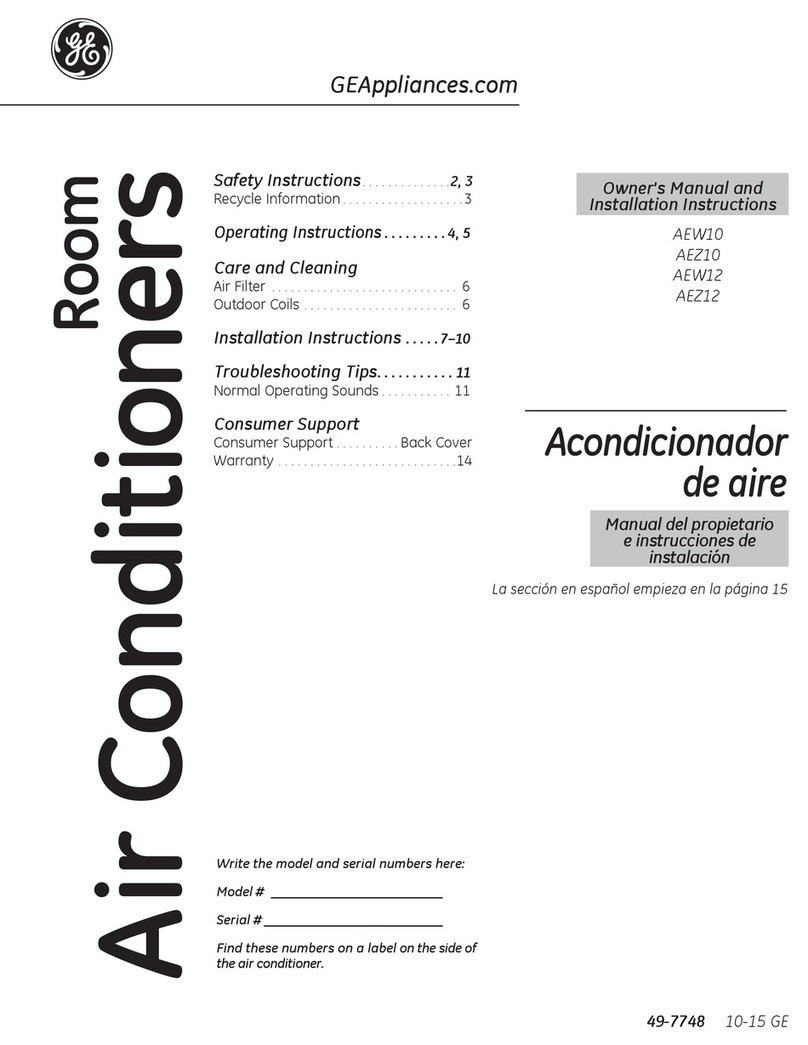
GE
GE AEZ10AVL1 Owner's manual and installation instructions

